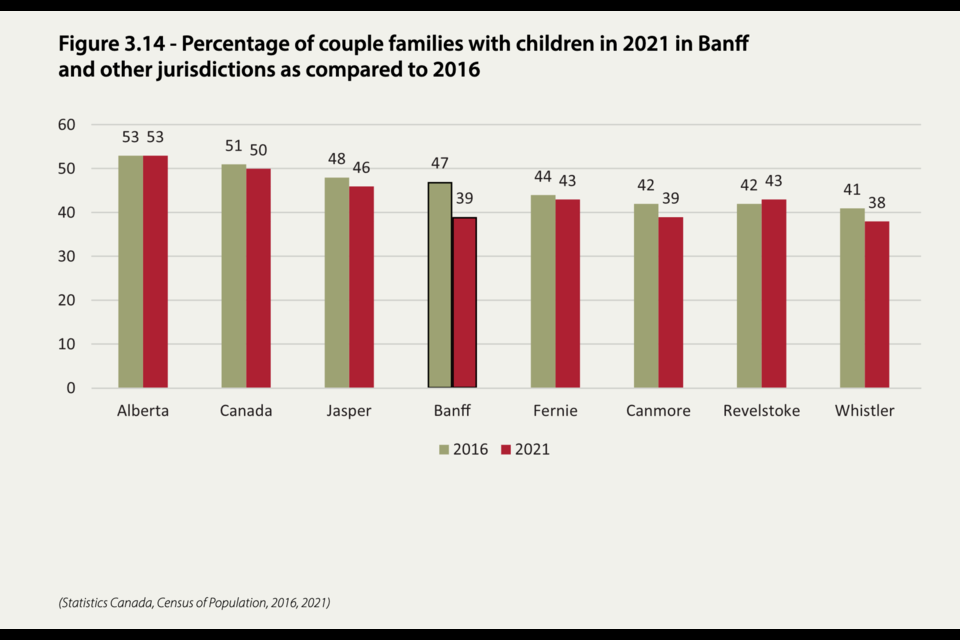BANFF – Affordable housing and childcare challenges have led to notably fewer families with children living in Banff.
A key finding in the new community social assessment, which was released by the Town of Banff on Jan. 22, shows there has been a substantial decline in two-parent families with children, dropping from 47 per cent in 2016 to 39 per cent in 2021.
While families indicate Banff is family-friendly, Town of Banff officials say a lack of appropriate, affordable housing and childcare challenges are barriers to staying long-term in the community.
Alison Gerrits, Banff’s director of community services, said although this trend is seen in other tourist places such as Jasper, Canmore and Whistler, the changes in these communities are significantly less than the marked shift in Banff from 2016 to 2021.
“This is a very significant finding in the data and highlights a shift in our demographic makeup over the five-year period,” she said.
Banff saw the largest percentage point drop over that five-year period at eight per cent. Canmore and Whistler saw the number of two-parent families with children drop three per cent.
Gerrits said, notably, Banff’s percentage is identical to Canmore and very similar to Whistler, marking a substantial change from the findings in 2016
"In five short years, we are now identical to Canmore in this regard, with only Whistler having a smaller percentage at 38 per cent,” said Gerrits.
“The last assessment showed Banff pretty much in the middle of the pack in terms of comparator communities.”
When looking at age groups in Banff over time, children as a percentage of the population have also dropped.
“They now collectively represent 13.5 per cent of Banff’s population as compared to 17 per cent 15 years ago,” said Gerrits.
Mayor Corrie DiManno said a healthy, diverse community should strive to be a liveable place for families, as they are an important part of the social fabric in Banff.
“Which is why it’s certainly surprising, and even worrying, to see us lose some of that demographic from the last assessment,” she said.
“We will spend time examining this issue and finding ways to ensure we are creating the conditions and opportunities for families to stay in town and to thrive in town.”
The 2023 community social assessment, however, identifies a rise in the proportion of Banff’s population aged 50 and over.
In 2021, individuals aged 50-64 made up 18 per cent of the population, compared to 13 per cent in 2016, while those aged 65 and older make up 12 per cent, up from six per cent in the 2021 federal census.
Gerrits said it is worth noting that the number of seniors in Banff is lower than in other comparable communities with the exception of Whistler.
“We’re most in line with Jasper and, out of interest, our neighbours down the road in Canmore see a significantly larger percentage,” she said, noting 17 per cent of Canmore residents are 65-plus. “Nationally, 19 per cent of individuals are over the age of 65.”
Young adults, meanwhile, continue to be attracted to Banff.
At 13 per cent of the total population, the 25-29-year-old age range is the largest five-year age cohort in Banff, according to the social assessment, and at 33 per cent of the population, Banff continues to have a greater percentage of 20-34-year olds than the rest of the province.
Gerrits said this enduring trend dates back more than three decades since the municipality formed in 1991.
“Ultimately, those 20-34 years of age have constantly represented more of Banff’s population as compared to the province when we look at all years going back to incorporation,” said Gerrits.
“My sense is that would have remained true even prior to that."
In 2021, the federal census counted 1,790 census families in Banff, which was up 14 per cent from 2016. Statistics Canada counts census families, which are defined as married, or common law couples with or without children, and one-parent families.
Gerrits said one unique characteristic in this data set for Banff is the notably higher percentage of people who have never been married or lived common compared to Alberta or Canada, at 38 per cent.
“Although still a high percentage of never married at 38 per cent in 2021, we have seen this number drop six percentage points when we look back over 15 years,” he said.
When looking at Banff’s never-been-married and not living in common law population as compared to Alberta and communities of Cochrane, Fernie, Canmore, Revelstoke, Jasper and Whistler, Banff remains most closely aligned with the communities of Jasper and Whistler.
As was the case in previous assessments, Gerrits said a noticeable difference was observed between Banff and Canmore.
“Canmore, where 26.3 per cent of the population are not living common law and have never been married, and further east to the community of Cochrane, where this demographic represents just under 20 per cent of the population,” she said.




